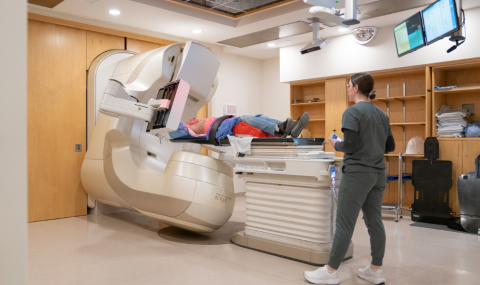All critically ill patients are at risk for a variety of possible complications. Immobility, the use of invasive lines and tubes, underlying health problems and decreased immunity are some of the reasons.
Health care research has helped us to understand some of the common complications of critical illness, as well as the treatments that are most likely to prevent these complications from occurring. We initiate a number of routine practices and treatments to reduce the chance of complications (provided that the treatment is considered safe for that particular patient). Although we try very hard to prevent complications from occurring, patients can have complications despite our best efforts and prevention strategies.
You may observe a number of procedures or practices when visiting the CCTC, that are being done to reduce the chance of complications. Here are some of the common examples:
Preventing the Spread of Infection
All health care personnel are trained in the correct methods and frequency for hand hygiene. Posters are located throughout the hospital, reminding visitors and staff of the four moments of hand hygiene. Hand hygiene products are accessible at hospital entrances, washrooms, cafeterias and in all patient care areas.
Specific protocols are followed when sterile procedures are performed or when equipment is cleaned. Click to find out how you can help to prevent the spread of infection.
Prevention of Pneumonia
Many patients are admitted to the CCTC because they have pneumonia (infection in the lung). Any patient who is bedridden, who has a breathing tube in place, or who is critically ill, can also develop pneumonia. Trauma patients may have aspirated (choked on the secretions from their mouth) or had injury to their lungs at the time of the accident that also increase the risk. The reasons why a patient can develop pneumonia when they are critically ill are complex, and there are often many different factors that contribute to this complication. The longer that a patient is critically ill and on a ventilator, the gater the risk.
Several of the practices and treatments used in CCTC play a role in decreasing the chance for developing pneumonia. Examples of some of the treatments include:
- Early feeding to keep the breathing muscles strong
- Keeping the head of the bed elevated to prevent oral or stomach contents from entering the lungs
- Regular mouth cleaning and rinsing with an antibacterial solution to reduce the number of germs
- Special breathing tubes with a suction port to clear saliva and secretions
- Regular evaluation of medication doses to use the lowest amount necessary of drugs that have a sedating effect.
- Daily assessment to see if the patient is ready to breathe without the ventilator.
- Sitting the patient up in bed or a chair as soon as the patient is able.
Prevention of Blood Stream Infections
All vascular devices are inserted after careful cleaning of the skin. Central venous and arterial lines are inserted with sterile procedures similar to an Operating Room practice. We keep antiseptic caps on all IV access ports and maintain transparent dressings with antibacterial coating over vascular site. We review our lines daily and try to remove them as soon as patients no longer need them.
Patients may develop a blood stream infection that is not related to indwelling catheters. For example, the bacteria that causes an infection in another area of the body may enter the bloodstream and cause the blood culture to be positive with the same organisms.
Prevention of Urinary Tract Infections
Most patients require a bladder catheter while in critical care to allow us to closely monitor fluid balance on an hourly basis and to prevent skin breakdown from incontinence. Drainage catheters are secured to the patient's leg to prevent pulling, and drainage bags are kept below the bladder to prevent urine from backing up. As soon as catheters are no longer required, we remove them.
Confusion and Delirium
Confusion and delirium is common among critically ill patients, particularly when they begin to awaken from a period of deep sleep or coma. Delirium can be distressing for patients and families, and can interfere with a patients recovery by increasing the amount of work that the heart and breathing systems must do.
Medications that control pain, anxiety or agitation can help to keep the patient calm and support his or her recovery. Agitation can make it very difficult to ventilate patients and can inhibit efforts to wean the patient from the ventilator when they begin to recover. Medications may be needed to control agitation. These medications are slowly reduced and removed as the patient gets better. Confusion or delirium that is not due to a direct brain injury is often an indication that the patient has been very sick. This type of delirium will usually go away after the patient has recovered, but it can take days or even weeks.
Restraints
Confused or delirious patients frequently attempt to pull out life saving lines and tubes, such as breathing or feeding tubes. Even patients who are oriented and aware may be temporarily disoriented when they awaken, and grab for their lines and tubes. Disoriented patients can remove tubes very quickly, even when a nurse is within arms reach of a bedside.
Restraints, in conjunction with medications that ensure the patient is comfortable, may be needed to prevent the patient from harming himself/herself. Often, a loosely tied wrist restraint is all that is needed to prevent a startled patient from suddenly reaching a tube.
If a nurse feels it is necessary to use restraints to prevent patient harm, you will be asked for your permission. Our protocol is to use the least amount of restraint required to prevent patient harm. When used, restraints are removed regularly to inspect the condition of the skin and limb. The nurse may feel it is safe to remove the restraints when family is at the bedside. If a restraint is removed during your visit, please advise the nurse before you leave the bedside.
You are not required to consent to the use of restraints. If you do not want any restraints used, you will be asked to sign a release form and be asked to assist the team in developing an alternate plan to keep the patient safe.
Early Feeding
Patients who are critically ill can quickly lose weight, including important muscle mass. When patients are very sick, they will often look very swollen and bloated. This bloating is fluid in the tissues, and can hide the actual loss of body protein. Protein is important to the muscles that control our breathing and other organs.
If a patient has a breathing tube in place, they cannot swallow. A feeding tube will be inserted through the patients nose or mouth and into the stomach or small bowel, to deliver nourishment. If the patient's stomach or bowel is not working properly, high calorie intravenous feeding (called TPN) will be given.
Prevention of Pressure Injury
Pressure injuries occur when blood flow to the skin is reduced from lying in the same position too long. It can also occur when objects such as tubes or medical devices press against the skin. Alert individuals who are able to recognize discomfort automatically change their body position which prevents this from happening. Critically ill patients have many other risk factors for pressure injury. Low blood flow and medication used to treat low blood pressure can decrease the flow of blood to the skin. Critically ill patients are often very swollen (called edema). Fluid under the skin makes tissues more fragile. Moisture on the skin due to sweating, draining wounds, incontinence or edema can cause the skin to break down. Loss of lean body fat and muscle mass reduces both the protective layer and the buiding block for new skin growth. Prior state of health and nutrition, as well as body size (very large or very thin patients are at higher risk for skin breakdown) can also impact the risk for pressure injuries. During times of extreme cardiovascular or respiratory instability, patients may be unable to tolerate any form of repositioning.
Prevention of pressure injury is a routine part of our practice. Nurses inspect each patient’s skin and reposition them routinely throughout each shift. All of our mattresses provide some level of pressure relief and feeding is started as soon as possible after admission. When a patient’s risk increases, we may move them to a bed with additional features including higher pressure relief. Some of our beds can also automatically provide gentle rotation. Despite all of our prevention strategies, pressure injuries can develop in critically ill patients. While most of these are superficial injuries that respond well to treatment, more complex wounds are followed by a specialized team of wound care nurses.
Prevention of Blood Clots
Critically ill patients are at risk for developing blood clots in the veins of their legs, pelvis and other areas of the body (called a deep vein thrombosis). These can cause swelling and pain in the area around the blood clot, however, they can also break away and travel to the blood vessels of the lung (called a pulmonary embolus).
To reduce the risk for blood clots, most patients will be placed on a low dose blood thinner (called anticoagulants). This is usually given to the patient in the form of an injection under the surface of the skin. You may notice purple bruising on the patients skin, especially over the arms and abdomen. This bruising is normal when a blood thinner is used.
Blood thinners can increase the risk for bleeding. Although the risk of serious bleeding is low for most patients, certain conditions can put the patient at greater risk. If we cannot use a blood thinner, we may use special compression stockings on the legs instead of blood thinners, to help keep blood flowing from the leg veins to the heart.
Prevention of Bleeding from the Stomach
Patients who are critically ill and on ventilators can develop bleeding in the lining of the stomach and food passages. Patients are put on medications to control acid production and lower the chance of bleeding.
Tell me about Quality and Safety.
How can I help prevent the spread of infection?
What is Medication Reconciliation?
Updated: October 30, 2018



